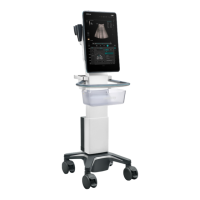6 - 2 Operator’s Manual
6 Image Acquisition
The adjustment function is disabled for wireless probe.
Steer
To steer the beam the probe transmits.
FOV Size
You can get a much larger field of view when selecting a larger FOV, but the frame rate will
decrease.
ExFOV
Tap [ExFov] to turn on/off the function.
For linear probes, the ExFOV function displays as trapezoid imaging.
For convex and phase probes, the ExFOV function displays as extending the scan angle.
Depth
This function is used to adjust the sampling depth, the real-time value of which is displayed in the
image parameter area in the top-left corner of the screen.
Increase the depth to see tissue in deeper locations, or decrease the depth to see tissue in shallower
locations.
TGC
The system compensates the signals from deeper tissue by segments to optimize the image.
Acoustic power
Refers to the power of ultrasonic waves transmitted by the probe, the real-time value of which is
displayed in the top-left part of the screen.
You should perform exams according to actual situation and follow the ALARA Principle.
Focus
Refers to adjusting the focus of the ultrasonic beams, using the focus arrow symbols which are
displayed to the right of the image.
Image Adjustment
More information can be obtained without moving the probe or changing the sampling position.
• FOV (Field of View): You can get a much larger field of view when selecting a larger FOV.
The frame rate decreases when using a larger FOV.
• Steering: Use to adjust the steer angle.
• ExFOV (Extended FOV): Off represents no ExFOV effect.
– For linear probes, the ExFOV function displays as trapezoid imaging.
– For convex probes, the ExFOV function displays as extending the scanning angle.
• The FOV position/range is available only for the convex and phased probes.
• When the scan range is adjusted to the widest, the FOV position cannot be changed.
• The steering function is available only for linear probes.
• The FOV Size is disabled for linear probe.

